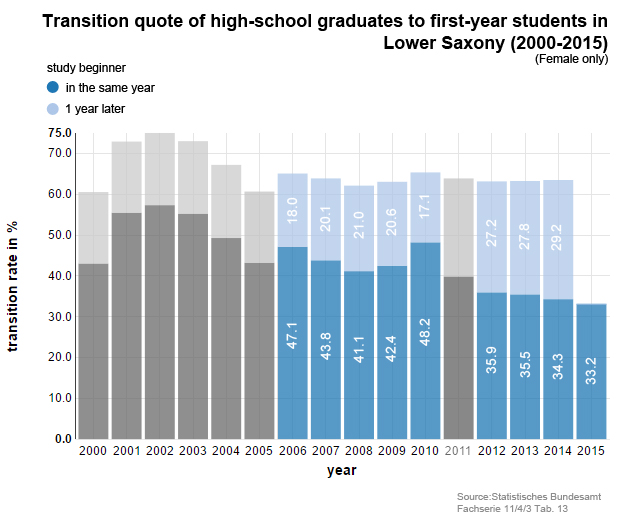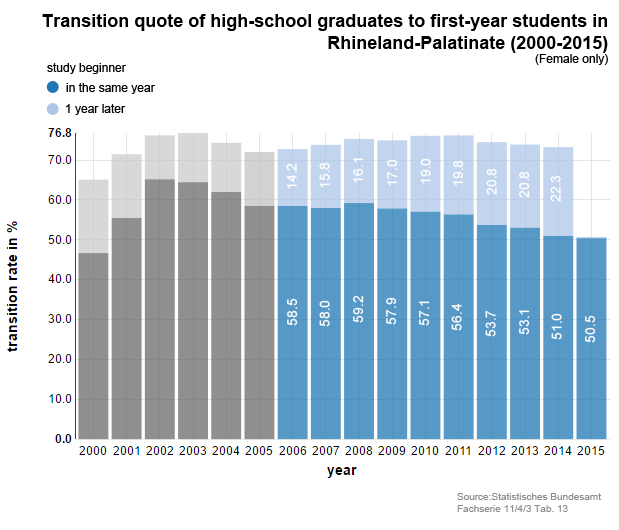Do the G8/G9 schooling systems really affect the transiton rate?
by Adrian Derstroff, Fabian Meyer
There is no change in the school-system of Germany that has been discussed as heavily as the change from 9 years (G9) to 8 years of high-school (G8). The points people discuss are vast. Both fronts, defenders and critics of G8, gained a lot of publicity with successes on both sides. Lower Saxony has already backpedaled on the decision and are reverting back to G9. Bavaria is still very much in the thought process of doing it, while writing this article.
Different studies have been published on the topic to take the heat out of the discussion. But while some of them could not find that the missing year is affecting the G8 students, others suggest that it has a definite effect.
We want to throw in another view on the topic, because it is actually a story about us, the authors, of this article. Fabian made the experience of going through the G8 system in Lower-Saxony, which made this change in 2011. Adrian studied in Rhineland-Palatinate under the G9 school-system, who have only been recently introducing G8 in a few selected schools in 2016. We are both now students at the University of Koblenz. In that regard we wanted to check if the students willingness to go study at a university or college is affected by it.
What we propose is that G8 students are less likely to go continue studying immediately after finishing up high-school and are less likely to study at all. This is based on the thought that the workload per week was upped by 5 hours a week to 33 for G8 students. Making it more likely for students to burn out and discourage them from studying again afterwards.
Therefore we wanted to look at the transition rate of the fraction of enrollments at universities in germany by the number of university entrance qualifications of a certain federal state before and after a G9 to G8 change. We expect to see a decrease in Lower-Saxony after the time of change while the transition rate in Rhineland-Palatinate should stay the same where there has been no change at that time.
Distorting factors
We of course did not pick Lower Saxony and Rhineland-Palatinate just basing it of the fact that we came from there, but because they actually make excellent role models. During the last 10 years 3 major events had a major impact on the german school-system as a whole as well as on the number of enrollments in all of germany.
- The Bologna process had the target of creating the european higher education area, which introduced the replacement of diplomas with two-part bachelor and master. A massive change to the university and college structure. Consequently 2005 transition rate and study beginners dropped on a minimum for almost every federal state and consequently for whole germany. We have to take this into consideration but sadly cannot factor it out.
- In 2011 conscription (military service) has been put in abeyance. Since conscription only affected men the transition rate in the same year jumps up around 20% for men. Meaning 20% more of the high-school graduates that are men immediately begin to study. It looks different though when you take the year after in consideration, too. The difference between the transition rate before 2011 and after ranges around 0%: Definitely men were not encouraged by this change to study. They were just getting into university one year earlier. Nevertheless we want to restrict ourselves to females only to account for this.
- In 1990 the reunification caused a drop in birth rate by close to a half in eastern states. This was caused by inner migration of adults of the age of 18 to 35 into the western states. 19 years later, exactly the age of the high-school graduates, their number drops also by half. This leaves more spots open in the universities. Since transition from mostly western states does not cover that up. Transition rate consequently goes up by the principle of supply and demand. Therefore eastern states do not make for good candidates while it also affects western states.
Lower Saxony and Rhineland-Palatinate make for a good candidate because they are not eastern states, as reasoned above. And they have a considerably high population and are therefore less error-prone to variations. The early change in Lower Saxony from G9 to G8 with first graduations in 2011 is beneficial, leaving more data after the change. Therefore Rhineland-Palatinate represents the opposite site well, where changes to the schooling-system were made only recently and only in a few schools.
Surprising results
While looking at the high-school graduates in Lower Saxony that enrolled at a university the same year they had graduated (only the dark blue bars), a decrease in transition rate after 2011 can be seen. However by adding those that enrolled one year later (sum of the stacked bars) the difference in decrease isn’t that obvious anymore.
That is why we also calculate the median before and after the transition year and subtract the median after the transition year with the one before the transition year.
By comparing the median of the transition rate before the transition year with the transition rate after we only see a decrease of 2.22% in transition rate. By only considering the past 5 years before the transition year the decrease would be even lower. So by looking at Lower Saxony our hypothesis couldn’t be approved. The only thing to note is that more students tend to enroll one year after their graduation from high-school than before 2011.
We then checked Saarland, and Bavaria and even Saxony-Anhalt, Mecklenburg-West Pomerania and saw that all of them have an increase of 1-3% in transition rate after the transition year.
By that our hypothesis would be wrong, since we don’t expect to see an increase even by only considering female students.
Even worse when checking Rhineland-Palatinate we see that the transition rate decreases even though Rhineland-Palatinate never really switched to G8. Additionally federal states like Saxony and Thuringia had an increase in the transition rate even though they never changed their G8 education system.
Conclusion
While the change between G9 and G8 might have an impact on the transition rate, it is not very significant since other factors had a bigger impact on the transition rate. Considering the number of study beginners reaches new heights almost every year in the old federal states, universities might have reached their capacities. It would have the reverted effect we talked about in the old federal states: Transition rate goes down.
However in Lower-Saxony we saw that while the total transition rate didn’t decrease by much that students tend to study a year after their high-school graduation, which could be a sign that they might not have withdrawn the idea to study but at least wanted to take a break and recover from the stressful time under G8.


Be First to Comment